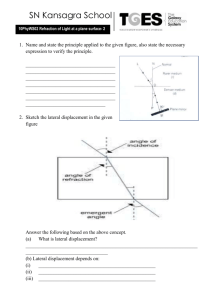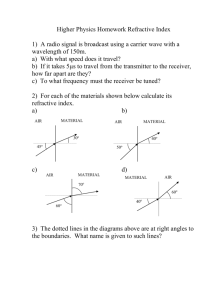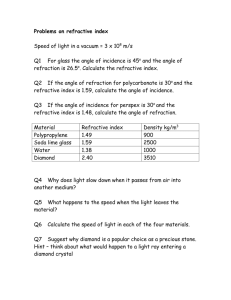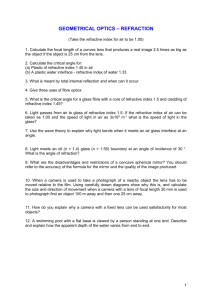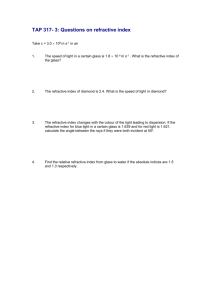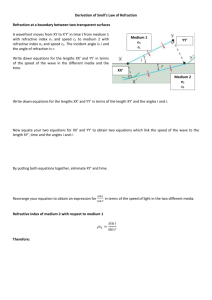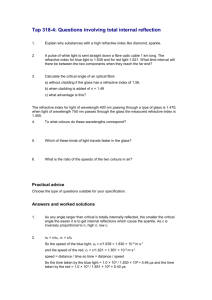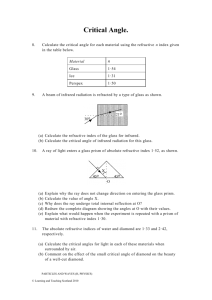Determination of the refractive index of a glass block
advertisement
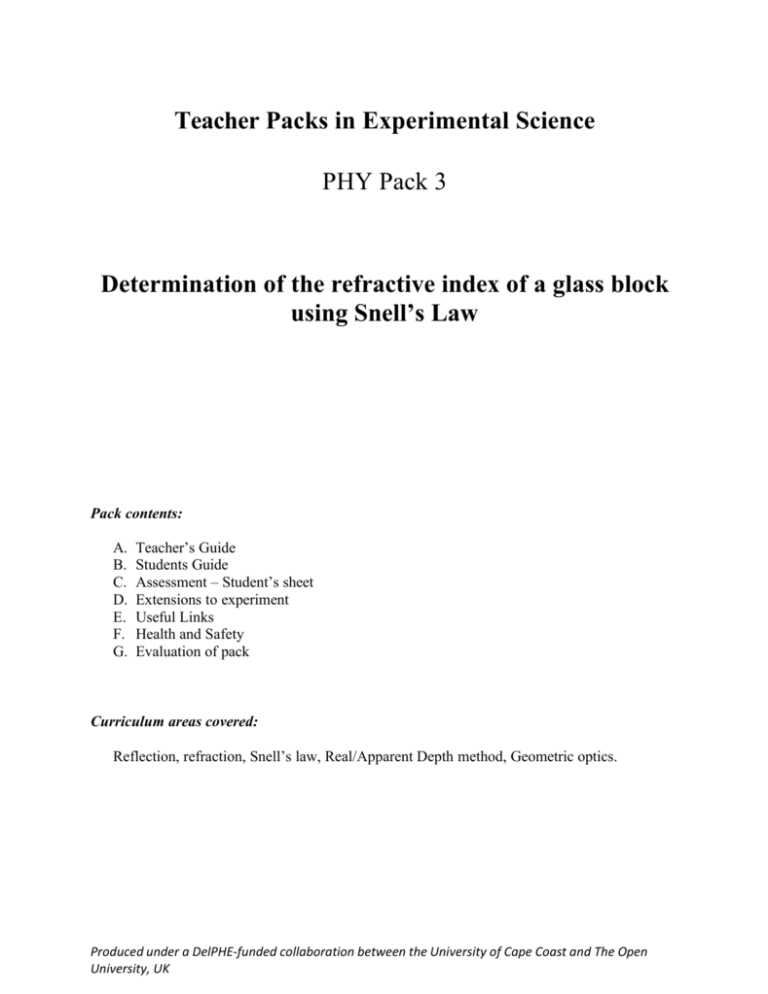
Teacher Packs in Experimental Science PHY Pack 3 Determination of the refractive index of a glass block using Snell’s Law Pack contents: A. B. C. D. E. F. G. Teacher’s Guide Students Guide Assessment – Student’s sheet Extensions to experiment Useful Links Health and Safety Evaluation of pack Curriculum areas covered: Reflection, refraction, Snell’s law, Real/Apparent Depth method, Geometric optics. Produced under a DelPHE-funded collaboration between the University of Cape Coast and The Open University, UK PHY Pack 4 - Refractive Index (Snell’s Law) Title: Determination of the refractive index of a glass block using Snell’s Law Target group: Diploma in Basic Education Students Also suitable for: B.Ed (Basic Education) Duration of Activity: 45mins plus a minimum of 15mins for discussion. Learning outcomes: At the end of the experiment the student should be able to: 1. Knowledge and Understanding (KN) KN1 KN2 KN3 KN4 2. Cognitive Skills (CS) CS1 CS2 3. Key Skills (KS) KS1 KS2 4. Practical Skills (PS) KS3 KS4 PS1 PS2 PS3 PS4 PS5 Understand the meaning of the terms: refraction, refractive index, and parallax. Explain refraction in terms of Snell’s law and index of refraction Understand the behavior of light when it travels between different media State Snell’s Law? Explain the behavior of light when it moves from one medium to another. Explain the concept of dimensionless parameters, and most specifically the index of refraction Use physical laws to explain everyday physical phenomena Relate dimensionless quantities to physical concepts Analyze data scientifically To calculate the refractive of a glass block. Measure angles accurately Determine the refractive index of a given transparent glass block Follow the procedure to obtain values involved in the experiment. Set up an experiment according to verbal or written instructions. Make observations and record results 2 Produced by Physics group, University of Cape Coast, as part of a DelPHE funded Project PHY Pack 4 - Refractive Index (Snell’s Law) A. Teacher’s Guide Overview Students are asked to locate the image formed in a glass block with a search pin. Students are then asked to measure the real depth and apparent depth. From these, they are to determine the refractive index of the glass block. Aim The experiment is to enable the students to observe the image formed of an optical pin in the glass block and also use the data obtained to determine the refractive index of the glass block. Practical Skills developed 1. Use of the no-parallax technique to locate an apparent image of a real object 2. Determination of the refractive index of a block made of transparent material. Advice to Tutors 1. Encourage the students to use different orientation (switch from along the length to along the breadth or vice versa) of the glass block. 2. They should also record their readings systematically. 3. Create time to discuss the physics of what is going on and to introduce the concepts of refractive index Sample Assessment Questions with answers 1. What is Snell’s law? (KN4) Answer: For any pair of media, sin 1 n 2 = a constant known as refractive index, sin 2 n1 where θ1 is the angle of incidence in the first medium and θ2 is the angle of refraction in the second medium. n1 and n2 are the refractive indices of media 1 and 2 respectively. 2. Describe what happens to a ray of light when it passes from air through a denser medium and into air again (CS1) Answer: When the ray of light enters the dense medium the refracted ray bends towards the normal, and when it leaves into the air it bends away from the normal. The incident ray and the emergent ray in the air are parallel. 3. A student uses a glass block to determine the refractive index using the real and apparent depth method and obtained a value of 1.5. If he uses half the length of the same block, will the value of the refractive index change? Why? (CS2) Answer: No, the refractive index of the glass will not change because it is the same material. 4. A straw is put in a glass of water, describe your observation. (CS1) Answer: The straw will appear bent at the air-water interface due to refraction. 3 Produced by Physics group, University of Cape Coast, as part of a DelPHE funded Project PHY Pack 4 - Refractive Index (Snell’s Law) B. Student Guide Purpose To determine the refractive index of a glass block using the no-parallax method. Background to Experiment Visible light is a small portion of the spectrum of electromagnetic radiation, which extends from low energy (very long wavelength) radio waves to high energy (short wavelength) Xrays/Gamma rays. When light rays strike the boundary between two media, the rays can undergo several physical processes e.g. reflection, refraction, etc. In this experiment, we are interested in refraction. We can define refraction as “the bending of light rays as they move from one medium to another of different optical density”. We now know that light bends but in which direction does it bend? Is it away from the normal to the boundary or towards the normal? One physical parameter which can give a measure or degree of the bending after refraction is the index of refraction or simply the refractive index. Dimensionless physical quantities It is possible to obtain a quantity after mathematical manipulation that has no units attached to it. Such a quantity is said to be dimensionless. E.g. the refractive index n of a medium maybe defined as n speed of light in vacuum speed of light in medium Since the two speeds have the same units, dividing them cancels the units and so n has no units and is so become dimensionless. Index of Refraction The refractive index is a dimensionless parameter that helps us in our estimation or determination of the degree of bending of a ray of light entering one medium from another. The refractive index n can also be defined for a particular material as the ratio of the speed of light in vacuum or free space to the velocity of light through the material (See Equation 1.1). N Incident ray θ1 medium 1, n1 Figure 1.1 Refraction of light at the boundary between two media θ2 medium 2, n2 Refracted ray The refractive index also depends on the wavelength (colour) of the light ray. Note that standard values of refractive indices given for materials or substances apply to yellow light of wavelength 589nm (1nm=1 nano meter =1 10 9 m ). 4 Produced by Physics group, University of Cape Coast, as part of a DelPHE funded Project PHY Pack 4 - Refractive Index (Snell’s Law) Generally, Snell’s law for light travelling from medium 1 to medium 2 (Refer to Figure 1.1) can be written as: sin 1 n2 speed of light in medium 1 (v1 ) sin 2 n1 speed of light in medium 2 (v2 ) 1.1 Apparent Depth An object on the bottom of a swimming pool or a clear lake appears to be closer to the surface than it actually is. This phenomenon may be understood by examining the light rays which pass from the object to the eye. N θ2 n2 D B n1 A θ2 Figure 1.2 Relation between real depth and apparent depth a θ1 r I θ1 d O Refraction causes an object immersed in a liquid of higher refractive index to appear closer to the surface than it actually is. This shallowing effect is illustrated in Figure 1.2. This is because the light from the point O that enters the eye is bent away from the normal as it emerges from the surface at point B. So the observer sees this ray appearing to come from the direction of B projected backwards into the water, along the dotted line, and so it seems to have come from the point I. The apparent depth is denoted by a and the real depth by r. Snell’s law applied at the surface gives sin 1 n 2 sin 2 n1 1.2 apparent depth a IA n2 real depth r OA n1 1.3 If medium 2 is air ( n2 1 ), then we write 5 Produced by Physics group, University of Cape Coast, as part of a DelPHE funded Project PHY Pack 4 - Refractive Index (Snell’s Law) apparent depth a IA 1 real depth r OA n1 1.4 from which we can find the refractive index of the medium in which the ray originates, n1, by rearranging to give: n1 real depth r apparent depth a 1.5 This implies the refractive index of a medium in air is equal to the ratio of the real depth to the apparent depth. No Parallax When one moves and observes distant objects, one notices that the farther object appears to move more slowly than the nearer object. The greater the distance between the two objects, the greater the rate of separation. When, however the two are very close, there is very little separation and there is no separation at all when the two objects coincide. This separation between the objects observed is called parallax. At the point where there is no parallax, the two objects coincide and they are at the same place or at the same distance from the observer. When there is no separation between the image and the image pin, the image pin marks the position of the image as there is no parallax. Aim: To find the refractive index of a glass block using the apparent depth method B O C A D C O B A D (a) (b) Figure 1: (a) Side view of experiment showing the optical pin O, drawing pin B and the glass block (b) the top view of experiment Equipments/Apparatus Glass block, optical pins, drawing pin, ruler. Experimental Procedure 1. Place the glass block on a flat surface 6 Produced by Physics group, University of Cape Coast, as part of a DelPHE funded Project PHY Pack 4 - Refractive Index (Snell’s Law) 2. Place an optical pin upright alongside the smallest face of the block. 3. View the image of the pin through the glass block from the opposite face and adjust the position of an inverted optical pin so that there is no parallax between the image of the lower part of the optical pin and the inverted one. 4. Measure OA, “the real depth “, and BA, “the apparent depth”. 5. Repeat the experiment three more times. 6. Tabulate your readings as shown below. Readings 1 2 3 4 OA ….. BA ….. OA/BA 7. Find the average of OA/BA. 8. What does the average value represent? Reflection on the experiment 1. What is meant by ‘no parallax’? 2. State two precautions taken to obtain accurate results. 7 Produced by Physics group, University of Cape Coast, as part of a DelPHE funded Project PHY Pack 4 - Refractive Index (Snell’s Law) C. Assessment – Student’s sheet On completion of the experiment, you should answer the following questions: 1. What is Snell’s law? (KN4) 2. Describe what happens to a ray of light when it passes from air through a denser medium and into air again? (CS1) 3. A student uses a glass block to determine the refractive index using the real and apparent depth method and obtains a value of 1.5. If he uses half the length of the same block, will the value of the refractive index change? Why? (CS2) 4. Describe what you would observe when a straw is placed in a glass of water (CS1). 8 Produced by Physics group, University of Cape Coast, as part of a DelPHE funded Project PHY Pack 4 - Refractive Index (Snell’s Law) D. Extensions to experiment In place of the transparent rectangular glass block use a transparent fluid. E. References and Other Useful Links 1. Abbot A. F. (1980), Ordinary Level Physics, 3rd Edition, Heinemann Books International, London. 2. Moss G. L. (1963), Ordinary Level Practical Physics, Heinemann Books International, London. 3. Nelkon M. and Parker P., (1987), Advanced Level Physics, Heinemann Educational Publishers, London. F. Health and Safety 1. Avoid pricking self with optical pins. 2. Be careful not to drop the glass block on the floor. G. Evaluation 9 Produced by Physics group, University of Cape Coast, as part of a DelPHE funded Project

